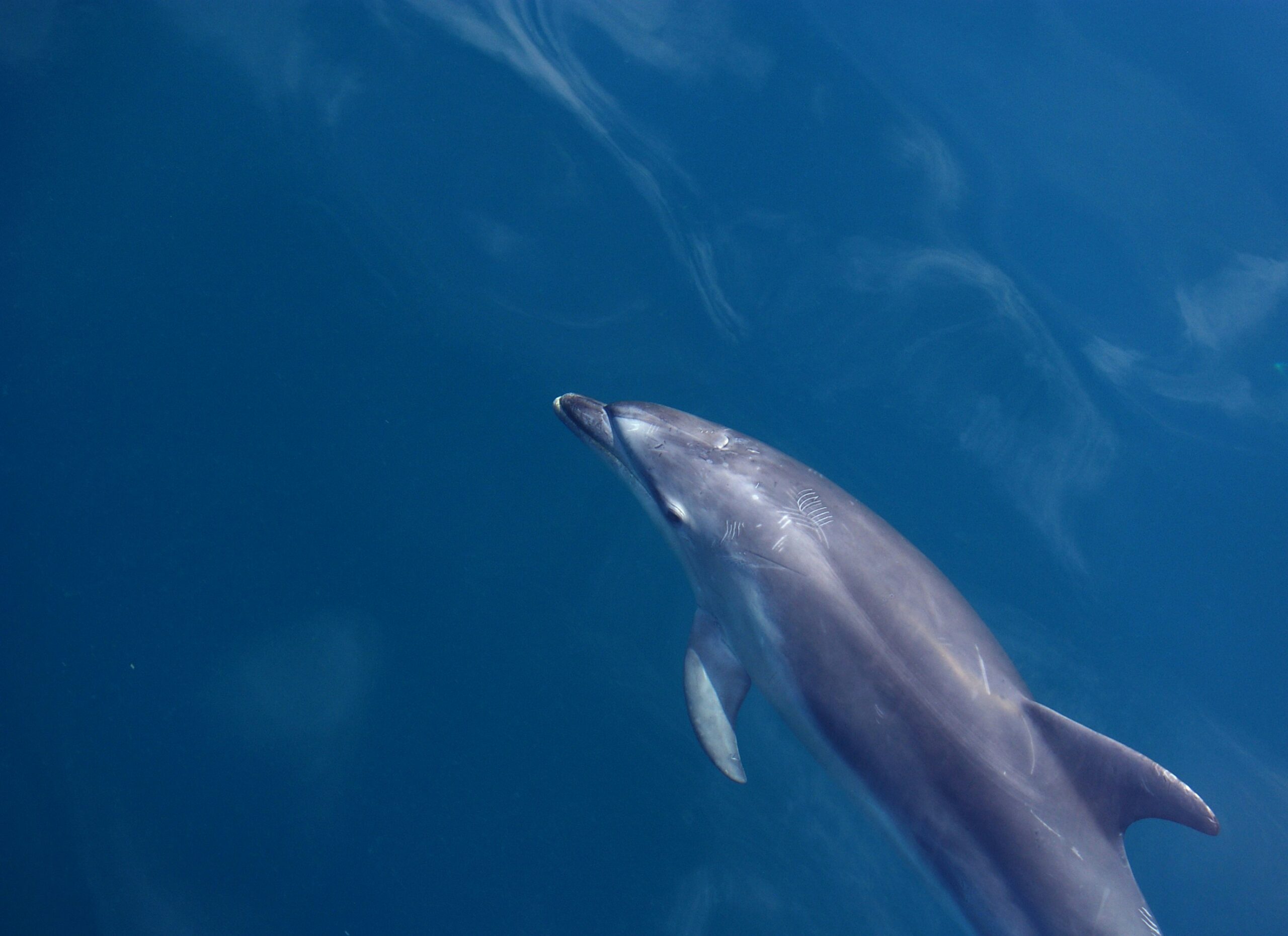
04 Oct Dolphin Behaviors You’ll Witness on a Blue Wave Adventure Tour
Dolphins are some of the most fascinating and intelligent creatures in the ocean, and seeing them in their natural habitat is an unforgettable experience. At Blue Wave Adventures, we’re lucky to witness dolphins displaying a variety of behaviors on our tours, offering our guests an up-close look at how these playful animals interact with each other and their environment. From breaching to tail slapping, dolphins are known for their social and energetic nature; each behavior tells us something unique about them.
In this blog, we’ll explain some common dolphin behaviors you can expect to see on a Blue Wave Adventure Tour and how to spot them during your dolphin-watching trip.
1. Breaching
Breaching is one of the most exciting dolphin behaviors to witness. This is when a dolphin leaps entirely out of the water, sometimes performing acrobatic flips before splashing back into the ocean. Scientists believe that dolphins breach for various reasons, including communication, play, and removing parasites from their skin.
How to Spot Breaching Dolphins:
- Look for splashes: Dolphins often create big splashes when they leap out of the water, so keep your eyes on the horizon for any sudden disturbances.
- Group excitement: Breaching tends to occur in social situations, so if you see one dolphin breach, others in the pod may follow.
2. Tail Slapping
Tail slapping, or lobtailing, occurs when a dolphin raises its tail out of the water and slaps it forcefully against the surface, creating a loud splash. This behavior is thought to be a form of communication, either to signal other dolphins or to warn off potential threats. Dolphins may also use tail slapping to herd fish while hunting.
How to Spot Tail Slapping:
- Watch for sudden, loud splashes: The noise created by tail slapping is unmistakable and can be heard from afar.
- Repeated motion: Dolphins often tail slap several times in a row, so once you hear the first slap, keep watching for more.
3. Spyhopping
Spyhopping is when a dolphin vertically raises its head above the water’s surface to get a better look at what’s happening around them. This behavior allows dolphins to observe their surroundings, including boats, people, and other marine animals. Spyhopping is especially common in curious dolphins investigating something new in their environment.
How to Spot Spyhopping:
- Look for heads peeking above the water: Dolphins will slowly rise out of the water, keeping their heads just above the surface to observe their surroundings.
- Curious behavior: Dolphins tend to spyhop when they’re curious about a boat or something nearby, so you may see this behavior when interacting with your tour boat.
4. Bow Riding
One of the most thrilling sights on a Blue Wave Adventure Tour is watching dolphins engage in bow riding. This occurs when dolphins swim right in front of the bow of the boat, riding the waves created by the vessel. Dolphins love to play in the pressure waves that boats generate, and they often jump and swim alongside the boat, giving passengers a close-up view of their playful behavior.
How to Spot Bow Riding:
- Look at the front of the boat: Dolphins will position themselves just in front of the boat’s bow, gliding through the water and occasionally jumping in and out of the waves.
- Fast-paced movement: Bow riding dolphins move quickly, so be ready with your camera to capture their impressive speed and agility.
5. Playing and Socializing
Dolphins are highly social animals, often seen playing and interacting with each other. They engage in playful behaviors such as chasing, spinning, and tossing seaweed back and forth. Play is an essential part of a dolphin’s life, helping to strengthen social bonds within the pod.
How to Spot Dolphins Playing:
- Look for playful chasing: Dolphins may chase each other or playfully swim in circles, often in shallow waters or near the surface.
- Objects in the water: Dolphins are known to interact with objects, such as seaweed or debris, which they toss and pass between each other.
6. Feeding Frenzy
Dolphins are skilled hunters; you might witness them feeding during your tour. They work together to herd schools of fish into tight clusters, making it easier for them to catch their prey. This behavior is often accompanied by rapid movements, splashing, and even seabirds diving into the water to snatch up fish stirred up by the dolphins.
How to Spot Feeding Dolphins:
- Look for fast, erratic movements: Feeding dolphins will swim quickly and erratically as they chase and catch fish.
- Seabirds nearby: Gulls and other seabirds often gather around feeding dolphins, diving into the water to catch fish.
7. Echolocation
While echolocation isn’t something you can see, it’s one of dolphins’ most remarkable abilities. Dolphins use echolocation to navigate and find food by emitting clicks and listening to the echoes that bounce back from objects in their environment. This allows them to “see” underwater, even in murky conditions.
How to Observe Echolocation in Action:
- Listen carefully: On some tours, you may hear dolphins making clicking sounds as they use echolocation to locate fish or navigate.
- Look for sudden direction changes: Dolphins may quickly change direction when using echolocation to zero in on a target.
8. Mating and Mother-Infant Bonding
During certain times of the year, you may witness dolphins engaging in mating behavior or see mother dolphins swimming with their calves. Dolphins are known for their strong maternal bonds, and mother dolphins are often spotted closely accompanying their young, teaching them how to navigate and survive in the wild.
How to Spot Mothers and Calves:
- Look for small dolphins: Calves are smaller and tend to swim alongside their mothers for protection and guidance.
- Close proximity: Mother dolphins usually stay very close to their young, often touching or swimming in unison.
Conclusion
Observing dolphins in the wild is a thrilling and educational experience, and on a Blue Wave Adventure Tour, you’ll have the opportunity to witness a variety of fascinating dolphin behaviors. From playful breaching and tail slapping to feeding frenzies and bow riding, each tour offers unique insights into the lives of these incredible marine mammals. Ready to experience the magic of dolphin behavior for yourself? Book your dolphin-watching tour with Blue Wave Adventures today and get ready for an unforgettable encounter with dolphins in their natural habitat!


Sorry, the comment form is closed at this time.